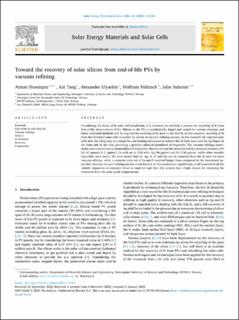| dc.contributor.author | Hoseinpur Kermani, Arman | |
| dc.contributor.author | Tang, Kai | |
| dc.contributor.author | Ulyashin, Alexander | |
| dc.contributor.author | Palitzch, Wolfram | |
| dc.contributor.author | Safarian, Jafar | |
| dc.date.accessioned | 2023-01-09T08:20:48Z | |
| dc.date.available | 2023-01-09T08:20:48Z | |
| dc.date.created | 2023-01-06T11:02:59Z | |
| dc.date.issued | 2023 | |
| dc.identifier.citation | Solar Energy Materials and Solar Cells, 2023, 521, 1-14. | en_US |
| dc.identifier.issn | 0927-0248 | |
| dc.identifier.uri | https://hdl.handle.net/11250/3041770 | |
| dc.description.abstract | Considering the boom of Si solar cell installation, it is necessary to establish a process for recycling of Si from End-of-life photovoltaics (PVs). Silicon in the PVs is synthetically doped and coated by various elements and hence dedicated methods will be required for recycling of Si, back to the SoG-Si. In this research, recycling of Si from the shredded solar cells is studied by means of vacuum refining process. In this research the rejected solar cells after the firing step are treated by acid etching techniques to remove the Al back layer and the Ag finger on the front side of the cells, providing a product called de-metallized Si fragments. The vacuum refining experiments were carried out on demetallized Si fragments. Results showed the demetallized Si contained presence of P (11.67 ppmw), B (1 ppmw), Ca with up to 0.28 wt%, Ag (96 ppmw) and Sn (136 ppmw), while other metallic impurities were lower. We have shown that Sn, Ag, O, N, and Mg can be removed from the Si melt via short vacuum refining, while a complete removal of Ca and P required longer times compared to the mentioned impurities. Because vacuum refining process is not limited by thermodynamic equilibrium, a full removal of all the volatile impurities at extended times is expected and then this process has a high chance for returning the recovered Si to the solar grade requirements. | en_US |
| dc.language.iso | eng | en_US |
| dc.publisher | Elsevier | en_US |
| dc.rights | Attribution-NonCommercial-NoDerivatives 4.0 Internasjonal | * |
| dc.rights.uri | http://creativecommons.org/licenses/by-nc-nd/4.0/deed.no | * |
| dc.subject | Evaporation | en_US |
| dc.subject | Recovery | en_US |
| dc.subject | Si feedstock | en_US |
| dc.subject | Solar-si | en_US |
| dc.subject | Vacuum refining | en_US |
| dc.subject | End-of-life Si cells (EoL-Si) | en_US |
| dc.title | Toward the recovery of solar silicon from end-of-life PVs by vacuum refining | en_US |
| dc.title.alternative | Toward the recovery of solar silicon from end-of-life PVs by vacuum refining | en_US |
| dc.type | Peer reviewed | en_US |
| dc.type | Journal article | en_US |
| dc.description.version | publishedVersion | en_US |
| dc.rights.holder | © 2023 The Authors. Published by Elsevier B.V. This is an open access article under the CC BY-NC-ND license (http://creativecommons.org/licenses/bync-nd/4.0/). | en_US |
| dc.source.pagenumber | 1-14 | en_US |
| dc.source.volume | 521 | en_US |
| dc.source.journal | Solar Energy Materials and Solar Cells | en_US |
| dc.identifier.doi | 10.1016/j.solmat.2023.112181 | |
| dc.identifier.cristin | 2101888 | |
| dc.source.articlenumber | 112181 | en_US |
| cristin.ispublished | true | |
| cristin.fulltext | original | |
| cristin.qualitycode | 2 | |

